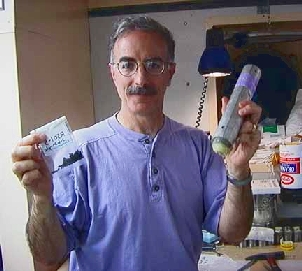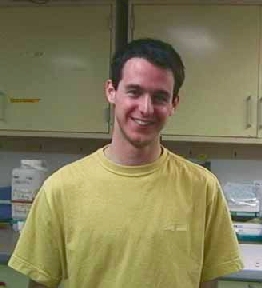WHAT'S NEW:
BACKGROUND:
Mission
Project Description
Cruise Plans:
Participants
Technology (ROV, ships, etc.)
Future Plans
Results:
1998 NeMO Cruise
Axial 1998 "Eruption"
Logbook
July 11, 1999
July 11, 1999
Contents:
- News from Thompson
- Participant Perspective
- Logbook from Teacher at Sea
- Question/Answer from shore to sea
Thompson Science Report
Science Report - Saturday, July 11
Ships Location: 45 56.0/130 00.8

"Chapstick corers" invented for dive 501 to collect volcanic glass chips. |
Listing of all Science News postings
Life at Sea: Participant Perspective
Christian Levesque
University of Quebec
 My name is
Christian Levesque and I am a Ph. D. student in biology at the University
of Quebec at Montreal (Canada). This is the third time I am going to sea
to study hydrothermal vents, and as such I think I must be one of the
luckiest students on Earth (or in Montreal, or at least in my neighbourhood!).
Back a few years ago, while I was wondering what I would do for a living,
the idea of doing scientific research was somewhat appealing to me, but
I certainly didn't expect that I was to spend weeks on the Pacific Ocean,
hundreds of kilometers from land, working with several other scientists
to understand these extremely fascinating systems deep down below. Hydrothermal
vent ecosystems are anything but boring; As a biologist, I am particularly
fascinated by the fact that, unlike other ecosystems on the planet, they
are supported by chemical energy rather than light. As these systems
are unique and recently discovered, we still know very little about the
biology and ecology of these extreme environments.
My name is
Christian Levesque and I am a Ph. D. student in biology at the University
of Quebec at Montreal (Canada). This is the third time I am going to sea
to study hydrothermal vents, and as such I think I must be one of the
luckiest students on Earth (or in Montreal, or at least in my neighbourhood!).
Back a few years ago, while I was wondering what I would do for a living,
the idea of doing scientific research was somewhat appealing to me, but
I certainly didn't expect that I was to spend weeks on the Pacific Ocean,
hundreds of kilometers from land, working with several other scientists
to understand these extremely fascinating systems deep down below. Hydrothermal
vent ecosystems are anything but boring; As a biologist, I am particularly
fascinated by the fact that, unlike other ecosystems on the planet, they
are supported by chemical energy rather than light. As these systems
are unique and recently discovered, we still know very little about the
biology and ecology of these extreme environments.
What I am particularly interested in is to understand what organisms eat at vents. As we are still discovering species that were previously unknown, we definitely don't know yet what the food chains look like. Understanding the feeding relationships between different species gives us insight into how they live together, why some species are most often found together and not with others, why and how the different populations of organisms evolve through time, how perturbations such as a new hot fluid source will affect the fauna, etc. Vent ecology is still a very young discipline, and these are among the first steps to try and understand a little better these ecosystems.
Since it is impossible to stay at a vent many hours and look close enough at animals to see what they actually eat and in what amount, the best way to elucidate feeding relationships is to use what we call tracers. Among those are stable isotopes of carbon, nitrogen and sulfur, and molecules like fatty acids. This might all seem a little complex, but its based on a simple idea: you are what you eat. These molecules or isotopes are found in certain amounts in each organism, and the animals that eat those will retain these molecules they took from their preys. Your cells are made of carbon, nitrogen, and molecules that come from the cereals, the carrots, the milk (and even the broccoli or spinach!) that you eat! Its exactly the same with palm worms or limpets at vents - although they probably don't have as much choice as we do in the grocery store!
Listing of all Perspectives postings
Teacher At Sea Logbook
Teachers Log #20 7/11/99
While observing the scientists prepare for a dive I noticed that all containers for sampling vent fluids and organisms were first filled with seawater. The reason this is done is to prevent the containers from being crushed by the pressure of the water as the ROV makes its way to the bottom. In fact, I'm told that if there is any air within the containers as they descend, that at about 15 meters below the surface they would implode and be crushed. Why does this happen?
When I stand out on deck, the air above me is pushing down with a force equal to one atmosphere of pressure. I don't even notice it. In fact, we all take it for granted. Imagine that I jump in (boy this water is cold) and swim downward, I feel the pressure in my ears. The rest of my body does not register this small amount of pressure increase. If I went deeper, say 1500 m down, any part of my body that contained air would collapse and be flattened. Not a pleasant thought. As you increase the depth of your dive, the pressure is a cumulative factor. For each 10 m (32 feet), you add one more atmosphere (atm). At 1500 m, where we are diving, the pressure is roughly 150 atm or just over 2200 lb. per square inch. This is one reason we use ROPOS to do our bidding at the bottom. Even it sometimes suffers from the extreme pressure below. All of the equipment on ROPOS has to be specially designed to operate in this high pressure environment.
 There has
been an increased level of artistic creativity around the ship. Styrofoam
cups and wig heads are becoming major art projects. Late in most cruises,
students mostly, but also some of the more grizzled veterans of the sea,
go about creating souvenirs for themselves and loved ones back home. After
designing and coloring the cups and wig heads, they are bagged and strapped
to the ROVs cage. When they come back to the surface, they are very small
because as they drop through the water column, increasing pressure
forces out the air trapped within the foam. Some, come up shriveled
and misshapen while others look like perfect miniatures. They make for
great conversation pieces.
There has
been an increased level of artistic creativity around the ship. Styrofoam
cups and wig heads are becoming major art projects. Late in most cruises,
students mostly, but also some of the more grizzled veterans of the sea,
go about creating souvenirs for themselves and loved ones back home. After
designing and coloring the cups and wig heads, they are bagged and strapped
to the ROVs cage. When they come back to the surface, they are very small
because as they drop through the water column, increasing pressure
forces out the air trapped within the foam. Some, come up shriveled
and misshapen while others look like perfect miniatures. They make for
great conversation pieces.
Bye for now.
Logbook of all Teacher At Sea postings
Questions & Answers
Questions from HMSC auditorium audience:
This is a more detailed answer to the questions posed on 7/10/99:
Q:Do they know what species of crab it was that was captured
on dive R498 and what is know about its life history? How big is it and
what was done with it?
A:
It is a known species: Macroregonia macrocheira.
This species was first described from two male specimens collected on the
Emperor Seamounts by Japanese trawlers. It is a majid crab related to
the king crab. Large males can reach a leg span of 1 meter.
We have studied the habits of this animal as it is one of the few normal
deep-sea animals that is able to tolerate the toxic sulphides at vents. The
males range widely in the deep-sea while we tend to find females and juveniles
clustered around the vents. They will pull tubeworms and snails from the
edges and move off to eat them. Males are agressive and often fight each
other - and even attack a submersible. We see females with incubating eggs
at the vents. I believe they are an important predator and a mechanism that
'transports' vent productivity into the surrounding deepsea.
All Questions/Answers from sea
![]() Send Your Question to NeMO
Send Your Question to NeMO
(oar.pmel.vents.webmaster@noaa.gov)